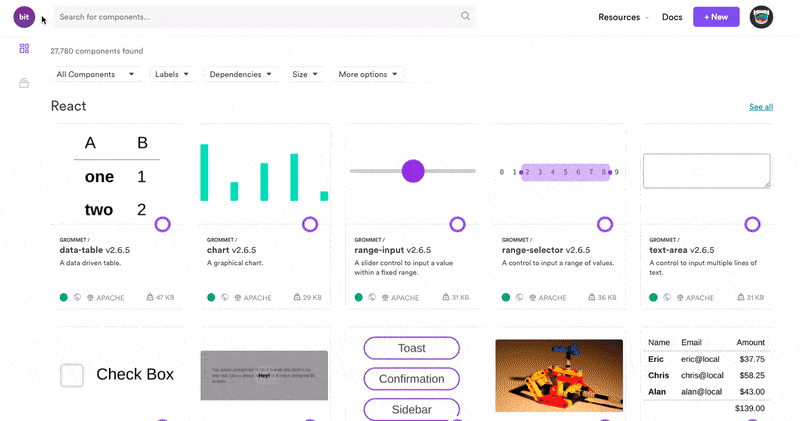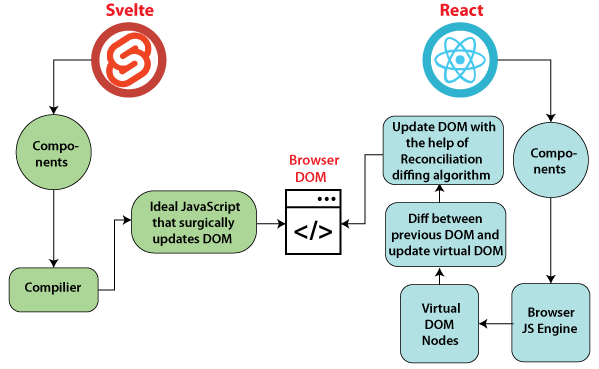React vs. Svelte
Both Svelt and React are tough competitors when discussing JavaScript frameworks. While React is an old player, Svelt is a new joiner.
It is said that React will shape the future, but it seems that Svelte is the future. So, to end this debate, let’s look at the basics of both the frameworks and decide which one is best for your needs, React or Svelte?

What is Svelte?
Svelte is an open-source, front-end JavaScript framework used to develop interactive web pages and apps. Rich Harris broadened with an initial release in November 2016. Svelte resembles React, Vue, and more when it comes to framework and web app development, but it is more.
Svelte features

Svelte is a young and growing framework that is slowly rushing to become one of the most popular. Now that you know what Svelte means, here are some of the main features that make Svelte so efficient.
Less code
The Svelte framework is known for fewer lines of code and simpler syntax. Since there are relatively few lines of code, developers can save time, avoid errors, bugs, etc., and increase ease of reliability. In addition, Svelte allows users to create multiple top-level elements and easily update the local state of variables. And this feature shapes Svelte’s future in the market.
Truly Reactive
Users can build applications according to the Svelte framework requirements without worrying about any unnecessary overhead. The DOM is updated only at the time of creation in Svelte. Svelte components have effectively incorporated React into the language to achieve greater ease of coding. Svelte minimize the lines of code as compared to React or Vue.
No virtual domain
As Svelte is a compiler, the .js file is loaded directly on the page to render the app, and Svelte’s code does not need to load the entire library on the browser. Also, the overhead generated by the virtual DOM is reduced in Svelte because all objects are updated only at compile time.
Svelte pros and cons
With the growing popularity of Svelte and the rapid increase in the number of developers adopting it, it is time to look at the various broad pros and cons of its choice.
Pros of Svelte
Some of the important features that have prompted various giants to choose Svelte for the development of their business solutions are,
Easily usable
Svelte is relatively easy to use as it has easy syntax and code for development. Code can be written in .html or .svelte file without using “this” in the code block. Hence, it becomes easy for developers to use Svelte for web application development.
Reduces overhead
Svelte minimizes the overhead of the JavaScript framework you are using. Code readability and reusability are improved by compiling Svelte to vanilla JavaScript. All this is responsible for the rapid development of web applications.
Compile without virtual Dom
In Svelte, the number of digital layers between the application and the browser is reduced, resulting in faster work and is highly optimized. This fact is a major selling point and is reflected in the performance of the Svelte as well.
Automatic updates
Svelte automatically updates your data with the help of declared variables. To improve the user experience, you no longer need to wait for changes reflected in the application.
Cons of Svelte
With so many features making Svelte the choice of various businesses, a few factors hold it back in certain areas. Let’s have a look at them,
Small Community
Any framework takes time to grow and expand its community. The same is the case with Svelte, and building a strong and huge community will take time. Open-source contributors are essential to building a community, and Svelte needs them.
No Cross-Platform Development
When using Svelte, you have to completely forget about cross-platform applications. If you are developing an app with Svelte, you will need to completely rewrite the code for the mobile app or opt for Hardwired NativeScript instead.
Less Comprehensive Development Tools
As Svelte is relatively young, you may not find many development tools of Svelte in the market. It is a rapidly growing ecosystem and demands contributions from the community for support in terms of the availability of development tools.
Limited Support for IDE Compatibility
IDE support is not as good as contemporary frameworks. It is the demand of every little problem in today’s world, and the internet cannot be surfed. Of course, you can find good online resources to address some issues. Still, a strong IDE is required.
Top Companies Using Svelte
A young and powerful player in the race for development infrastructure, Svelte already has some big names in its kitty. Let’s look at some successful companies that have used Svelte to grow their business solutions. So the Svelte examples are,
Avast
The antivirus giant, which has gained popularity among thousands of users, has adopted Svelte to develop its mobile app. Avast chose Svelt for the availability of several simple and convenient solutions that clearly defined its idea of the mobile application it wanted to develop.
Philips
Philips chose the Svelte for its stability and variety of features that can elevate the mobile experience to another level. Many developers believe that Svelte is comparatively faster than other frameworks. This belief has prompted Philips to choose Svelte for its mobile application development.
Decathlon
One of the most well-known sports equipment stores, Decathlon, also believed that Svelte was an ideal choice for developing their smart mobile application. The Decathlon’s Svelte app allows you to buy, return or exchange products and even collect points. Decathlon chose Svelt for code segmentation, optimization, etc.
The New York Times
An application was created for The New York Times using Svelte. This small and efficient framework was used to develop complex applications and provide easy context and an interactive experience and connection.
Chess.com
Svelte was used to develop the Chess.com application, an online chess platform, and millions of chess guides, lessons, etc. Chess.com chose svelte for its complete compatibility with IoT devices, quick implementation, and code reusability.
What Is React?
React is a JavaScript-based UI development library powered and developed by a vast community of developers on Meta (formerly known as Facebook) in May 2013. React is currently the most widely used front-end library for web development and provides various extensions. Application architecture, such as React Native, Flux, etc.
React features

React is the first choice of many giants, and there are many reasons for this. So, here are some reasons to choose React for your next project.
Virtual Dom
A virtual DOM is simply a representation of the original DOM. You can say that it is similar to one-way data binding. Thus, whenever a change is made to the app, the entire UI is first rendered in the virtual DOM, speeding up the process without wasting any money.
Declarative UI
With a declarative user interface, React’s code is simple, easily readable, and allows for quick and easy bug resolution. Thus, React has become the first and best choice for developing intuitive, interactive, engaging web and mobile applications.
Component-Based Architecture
React has a component-based architecture, which means that the application’s user interface consists of multiple components. Each component has a separate logic which is written in JavaScript. Due to this architecture, developers can move data across the app without changing the DOM.
React pros and cons
No technology or framework is perfect, and the same goes for React. So, let’s have a look at some of the major pros and cons of React to get to know this framework better,
React’s Pros
React is widely used by many big names in the market, and apparently, many factors prove it. So, here are some reasons to choose React,
Virtual Dom
The Virtual Document Object Model is primarily intended to enhance the user experience. The main advantage of Virtual DOM is its ability to update even minimal changes in real-time without causing any interruption to the interface. With DOM, React can speed up the entire web development process.
One Way Data Flow
React has a one-way data flow to eliminate the possibility of unstable code due to changes in child data affecting parent data. In React, any change to the child data does not affect the parent data. It gives developers the upper hand in giving them complete control over the data in case of complex projects.
Component Reusable
Since changes in one component do not affect other components in React, code components can be reused effectively in the case of large projects. In React, all components are isolated, allowing developers to save time by reusing code.
SEO friendly
Search engine rankings play a vital role in taking your business to the next level or knocking it down. With React, you get a lightweight JavaScript that all search engines like Google can easily read.
React Cons
Apart from the amazing features and benefits of React, you may also like to look at some of the drawbacks that can help you in your decision making,
Pace Of Development
Due to the fast pace of development of React, there are mixed views among developers. Some people find it easier with the rapid development of React, while others find it a pain to keep running it repeatedly.
Documentation
React is a rapidly evolving technology, and because of this, a lot of new tools, patterns, etc., are being added. It makes it difficult for the community to keep the documentation up to date with the latest resources and needed support.
jsx
Since JSX is a combined form of JavaScript and HTML, it becomes confusing for developers to understand the syntax. To create JavaScript objects with HTML syntax, React extensively uses JSX syntax extensions. But, JSX extensions can be complicated, and it can take time for developers to understand them.
Toolset is incomplete
When you choose React, you should be familiar with the fact that it can only be used to develop the UI of the application. Therefore, when you choose React to develop your business solution, you must choose a few other technologies to complete the development.
Top companies using react
Being one of the most preferred web development frameworks, React is loved, preferred, and used by many giants to develop complete business solutions with all the desired features. So, here are the top companies that are using React for their developed apps,
Facebook needs no introduction. Who doesn’t know Facebook, and who isn’t on Facebook? Facebook is a pioneer of React, so it is obvious that it uses React for web page development. Using React’s features in the best possible way, Facebook enhances the user experience with each passing day.
The most used app on everyone’s phone, WhatsApp has demanded React for its stable performance and security. The user interface of WhatsApp has been designed using React. Furthermore, the web versions of WhatsApp use React to enhance the user experience and take advantage of its best features.
Salesforce
The world’s largest CRM organization, Salesforce, is considered the best among its contemporaries. To quickly but efficiently render highly complex Visualforce pages, Salesforce decided to leverage the power of React. With React, Salesforce can render pages faster and create pages inside Visualforce.
Dropbox
Dropbox is an on-demand file hosting service that uses a cloud computing model. It allows users to store, share and manage files. Dropbox has adopted React to develop its applications due to its small file size, virtual DOM, community support, etc.
GitHub
GitHub is one of the largest software development platforms with a huge community of developers to help them with software design and development. GitHub chose React to develop its development framework because they believed in its capability and goodness.
Svelte is a Compiler, while React uses Virtual DOM.
Both React and Svelte offer a similar component-based architecture – meaning that both enable a CDD bottom-up development. Both enable their components to be shared between apps through tools and platforms like Bit.

The key difference between them is that Svelte is a compiler that ideally converts your application to JavaScript during build time instead of React, which uses virtual DOM to interpret the application code during runtime. Yes, that was quite the jargon.

React Virtual DOM
React uses a virtual DOM (VDOM) concept, where a virtual representation of the UI is kept in memory and synced with the real DOM through cohesion.
The reconciliation process will find the difference between the Virtual DOM (an object in memory where we push the latest updates to the UI) and the real DOM (the DOM that holds the previously rendered UI). Using specific heuristic algorithms, it decides how to update the UI. This process is fast, reliable, and highly responsive for the most part.
React bundles a certain amount of overhead code to achieve this, which will run in the browser’s JS engine to monitor and update the DOM based on various user interactions.
Svelte Compiler
Svelte is purely a compiler that turns your application into ideal JavaScript code as you build the application for production. This means that it will not inject any overhead code into the browser while your application is running to update the DOM.
This approach is relatively new compared to React, which generally takes advantage of virtual DOM.
Where Svelte is Strong
Let’s find out what key benefits we can gain by using Svelte.
- The build time is blazing fast as compared to React or other frameworks. Using the rollup plugin as a bundler might be the secret here.
- The bundle size is smaller and smaller than React, which is a huge plus point. Even with the shopping cart application, I’ve built, the initial load time and the time it takes to render the UI is extremely short. Only the chunky pictures I’ve added take some time.
- Binding classes and variables are relatively easy, and custom logic is unnecessary when binding classes.
- Scoping allows flexible styling within the CSS <style> component itself.
- Easier to understand and get started with than other frameworks as the key part of Svelte is plain JavaScript, HTML, and CSS.
- More simple store implementation than React’s context API, the provided context API provides more features, and svelte can be quite simple for common scenarios.
Where Svelte Falls Behind
Let’s find out where Svelte has its downsides.
- Svelte won’t listen for reference updates and array mutations, which are a huge hassle, and developers need to actively seek out and ensure that arrays are reassigned so that the UI is updated.
- The usage style for DOM events can also be annoying, as we need to follow Svelte’s specific syntax instead of using the predefined JS syntax. Can’t use onclick directly like in React, but instead have to use special syntax like onclick.
- Svelte is a new and young framework with minimal community support, making support for a wide range of plugins and integrations unnecessary for heavy production applications. React is a powerful contender here.
- No additional improvements. Ex-React Suspense actively controls your code and how it runs and tries to optimize when the DOM is updated, and sometimes even provides an automatic loading spinner while waiting for data. These additional features and continuous improvements are relatively few in Svelte.
- Some developers may prefer not to use special syntax like #if and #each in their templates and would instead prefer to use plain JavaScript, which React allows. It may come down to personal preferences.
Is Svelte better than react or vice versa?
Svelte provides notable improvements in some features as compared to React. But it still may not be important or big enough to replace React completely. The response is still strong and broadly adopted. Svelte has a lot to do. But concept-wise, the compilation approach taken by Svelte has proven that virtual DOM dereferencing isn’t the only way to build fast, responsive applications and a good enough compiler can do as good a job as it gets.
Which framework should we use for your next application?
While weighing the pros and cons, in my opinion, if you are building a small application like a simple e-commerce application for your startup, I would recommend Svelte. Svelte is easy to master if you have a good knowledge of JS, HTML, and CSS. With Svelte, you can build some powerful, fast, and lightweight applications.
For huge production applications requiring many integrations and specialized plugins, React may still be the way to go. Again, as React provides Next.js, Svelt also provides its own production-ready single-page application framework called Sapper, which may be worth looking at.
As I mentioned above, declaring a winner is challenging as they put on beautiful performances to achieve their primary goals. Both contenders are practical and efficient tools for creating great user interfaces. Choosing between the two is mostly based on your scenario and preferences.
Comparison Between Svelte Vs. React
After looking at React and Svelte, let us dive deep and understand Svelte Vs. React thoroughly.
1. Performance
Reactjs increases performance as it allows building with reusable components. Furthermore, its platform employs optimized coding practices that enhance the user experience and performance of the app.
Thus, it is easier to achieve consistency throughout the app development cycle with less code clutter.
On the other hand, Svelte minimizes runtime overload, leading to faster interface navigation. It also provides flexibility so that developers can produce high-quality code. Plus, as an IT business owner, you don’t have to worry about the complexities surrounding virtual DOM overhead. Thus, the apps developed through Svelte are powerful and sophisticated.
2. User experience
Comparison of Svelte for User Experience. React is an ultra-fast application, and it enhances the loading speed. As web pages load faster, it enhances the user experience. With an enhanced user experience, there is a higher chance of increasing your customers’ loyalty to the brands. Thus, it will create a win-win situation for you as a CTO.
Svelte supports component-based UI design and thus is exceptional at building lightweight apps. Along with a better user experience, the platform also enhances the response time. Page speed also increases as Svelte removes the middle-stage loading of the virtual DOM.
3. Code maintainability
React is a component-based architecture it focuses on customizing the UI and developing functional and individual code snippets. These code snippets can then be used in other apps of different modules.
As the codes can be used elsewhere, this app breakdown enhances the team’s productivity and efficiency. Moreover, as an IT business owner, you don’t have to worry about orienting a new developer.
The React platform itself has organized coding patterns and components that make the code easy to learn. Since the developers can feel at home with React, it increases the code maintainability.
The components of Svelte have a readable structure that helps define different app components. With Svelte, different pieces of a web application like buttons, forms, etc., work together easily. So along with acting in performance comparison, the platform helps the developers to maintain the code as well.
4. App size
As an IT business owner, you need to understand that Reactjs is a fully-featured front-end framework. Thus, it is easy to build larger and more complex applications using React. Also, with the latest development, it is easy to reduce app size by 30% using React JS.
Svelte is widely used in making small-size applications. Thus, it is the most accessible JavaScript component library, and it drives the development process in a better way.
5. Faster development
React has a reputation for being the fastest framework. Thus in the race for Svelt Vs. React, React has some edge. All you need is a team of developers familiar with basic JavaScript concepts. Once you know this, development speeds up, with configuration warnings, etc.
With Svelte, developers can easily develop more advanced features. Furthermore, they can separate the app structure and the design HTML markup. The framework here also has an excellent data structure and design functionality. Furthermore, it is easier for developers to develop rapidly with a clear separation of front-end controls and methodologies.
6. Testing
To facilitate the testing process, Reactjs provides test runners. Thus, it helps the QA team to trace the problem to the actual browser settings. In addition, it reduces app time-to-market, thereby increasing overall app productivity.
Developers can do unit testing with the Svelte testing library. The library is smaller in size and has less complex computations. Also, if in Svelte vs. React, you are looking for a ‘lean web’, then Svelte should be your choice.
Conclusion
There’s no doubt that the Svelt vs. React debate will continue with such loud perks.
Now it is up to the CTO to understand their business requirements and choose the platform. React and Svelte both have their share of perks, but it all depends on the nature of the app. Both the frameworks are component-based and are known to enhance the user experience. Thus, be sure of your options before opting for a framework.
